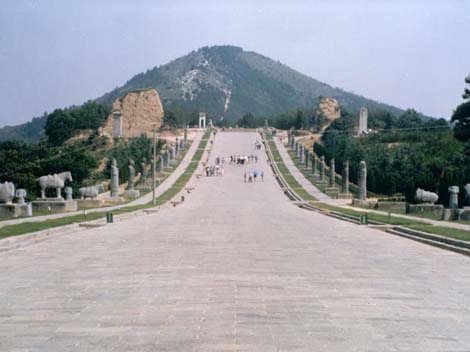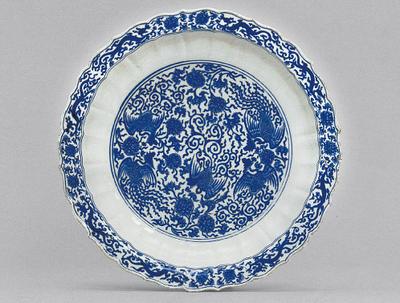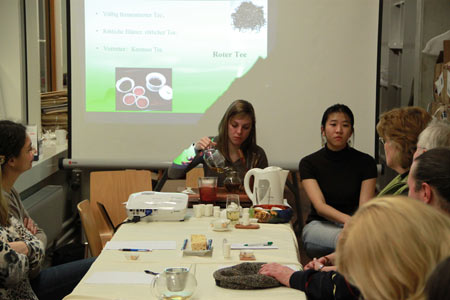| Home > China Feature |
A Sweet Art:Sugar Painting
In and around China’s southwestern Sichuan Province, it is usual to see some folk artists producing sugar paintings with liquid sugar along the streets, in the parks, and around the schools.
The artists normally sit before a wooden stand where there is a polished slab of marble in the middle. On the side of the stand is a revolvable bamboo arrow and a wooden plate painted with various patterns in a circle such as a loong (Chinese dragon), bird, dog, flower basket and so forth.
After paying about 5 jiao, or 1 to 2 yuan, the customer, normally kids, turn the arrow and wait till it stops. The pattern the still arrow points at is the one the artist is supposed to make with sugar.
Some rich kids or adults who do not want to gamble could order any pattern the artist could do by paying a higher price.
The painter uses the brown sugar or white sugar as the raw material, the bronze spoon and a shovel as the tool, and the slab of marble as the “paper”. To acquire liquid sugar, he/she has to cook the solid sugar in a pot before painting. The liquid sugar falls down as a thin thread onto the “paper” from the slanting spoon. After a short while, a plane animal is created, or even a solid bike and a flower basket. Then the painter separates the painting from the marble with a shovel, puts a wooden prod on the painting or wraps it with a transparent plastic bag, and gives it to the kid. In the sunshine, holding the shining sugar painting when walking along the street, the child is proud and happy.
As a unique art for producing artistic pieces entirely composed of sugar, sugar painting is very different from normal painting. First, since the hot liquid sugar could freeze solid if it cools, the painter has to produce his/her work very quickly. Second, the painter has to follow some orders of strokes and draw a continuous line into a picture of an animal or other pattern. To get familiar with the whole process, the painter has to do some practice of normal painting in the first place.
These impressionist-style paintings fall into two main categories: plane painting and solid painting. It is comparatively easier to do the former. When producing the latter, the painter needs more knowledge and techniques of sugar painting. For example, to produce a flower basket, he/she has to do a round sugar pancake first, and then make a smaller sugar circle on the pancake. Due to the difference of the two parts in temperature, it is easy to pull up the whole smaller and resilient sugar circle with some tool and form a solid basket. Later on, the artist adds a lifting beam and flowers to the basket, making a vivid flower basket.
According to some academic studies, sugar painting originated from the Ming Dynasty when sugar animals and figures were made in molds as part of a sacrifice in religious rituals. In the Qing Dynasty, sugar painting gained more popularity. The production techniques were upgraded and the patterns became more various, most of which were auspicious such as fish, loong and monkey. Afterward, the folk artists in Sichuan developed this art by incorporating techniques of Chinese shadow puppet and Chinese paper cutting. The molds were also replaced with a small bronze spoon. As time passed by, the contemporary form of sugar painting has gradually evolved.
Although the number of sugar painters has decreased, due to its unique charm, a certain number of artists are making sustained efforts to preserve it by offering classes, holding relevant activities such as sugar painting contests and applying for the National Non-material Cultural Heritage.
Nowadays, this art is garnering support again, from both the general public and the government. It has already been listed as Provincial Non-Material Culture Heritage by the Sichuan Government. Moreover, the sugar painting artists have gained increasing recognition.
Art
 more
moreSculpture in Qianling Mausoleum
The sculpture of Qianling Mausoleum is the main relic of the ground ...

A Sweet Art:Sugar Painting
In and around China’s southwestern Sichuan Province, it is usual to ...

Chinese Treasure Displayed at Sha...
There are four treasures of the Chu Minority Culture displayed at th...

Custom
 more
moreWeb Dictionary
Martial Arts
12 Excellent Kung Fu Movies in 2010 You Shouldn'...
Martial Arts film can be artful and stunningly beautiful, and they...
Shaolin Monks Perform Martial Art in Moscow
A monk from China's Shaolin Temple performs Shaolin mar...
Chinese Kungfu Films Ready for the New Year seas...
The two Chinese blockbusters Let the Bullets Fly and If You Are th...





 print
print  email
email  Favorite
Favorite  Transtlate
Transtlate 







